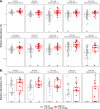Persistent Bacterial and Fungal Community Shifts Exhibited in Selenium-Contaminated Reclaimed Mine Soils
- PMID: 29915105
- PMCID: PMC6070768
- DOI: 10.1128/AEM.01394-18
Persistent Bacterial and Fungal Community Shifts Exhibited in Selenium-Contaminated Reclaimed Mine Soils
Abstract
Mining and other industrial activities worldwide have resulted in Se-enriched surface soils, which pose risks to human and environmental health. Although not well studied, microbial activity can alter Se bioavailability and distribution, even in oxic environments. We used high-throughput sequencing to profile bacterial and fungal communities inhabiting mine soils in southeastern Idaho, comparing mined and unmined locations within two reclaimed phosphate mine areas containing various Se concentrations. The goal was to determine whether microbial communities differed in (i) different mines, (ii) mined areas compared to unmined areas, and (iii) various soil Se concentrations. Though reclamation occurred 20 to 30 years ago, microbial community structures in mined soils were significantly altered compared to unmined soils, suggesting persistent mining-related impacts on soil processes. Additionally, operational taxonomic unit with a 97% sequence similarity cutoff (OTU0.03) richness and diversity were significantly diminished with increasing Se, though not with other geochemical parameters, suggesting that Se contamination shapes communities in favor of Se-tolerant microorganisms. Two bacterial phyla, Actinobacteria and Gemmatimonadetes, were enriched in high-Se soils, while for fungi, Ascomycota dominated all soils regardless of Se concentration. Combining diversity analyses and taxonomic patterns enables us to move toward connecting physiological function of microbial groups to Se biogeochemical cycling in oxic soil environments.IMPORTANCE Selenium contamination in natural environments is of great concern globally, and microbial processes are known to mediate Se transformations. Such transformations alter Se mobility, bioavailability, and toxicity, which can amplify or mitigate Se pollution. To date, nearly all studies investigating Se-microbe interactions have used culture-based approaches with anaerobic bacteria despite growing knowledge that (i) aerobic Se transformations can occur, (ii) such transformations can be mediated by microorganisms other than bacteria, and (iii) microbial community dynamics, rather than individual organismal activities, are important for metal(loid) cycling in natural environments. We examined bacterial and fungal communities in Se-contaminated reclaimed mine soils and found significant declines in diversity at high Se concentrations. Additionally, we identified specific taxonomic groups that tolerate excess Se and may be useful for bioremediation purposes. These patterns were similar across mines of different ages, suggesting that microbial community impacts may persist long after physicochemical parameters indicate complete site recovery.
Keywords: metalloids; metals; microbial ecology; microbiome; pollution.
Copyright © 2018 Rosenfeld et al.
Figures




Similar articles
-
Rhizosphere Microbial Response to Multiple Metal(loid)s in Different Contaminated Arable Soils Indicates Crop-Specific Metal-Microbe Interactions.Appl Environ Microbiol. 2018 Nov 30;84(24):e00701-18. doi: 10.1128/AEM.00701-18. Print 2018 Dec 15. Appl Environ Microbiol. 2018. PMID: 30291123 Free PMC article.
-
Soil Bacterial and Fungal Communities Show Distinct Recovery Patterns during Forest Ecosystem Restoration.Appl Environ Microbiol. 2017 Jun 30;83(14):e00966-17. doi: 10.1128/AEM.00966-17. Print 2017 Jul 15. Appl Environ Microbiol. 2017. PMID: 28476769 Free PMC article.
-
Organic mulching positively regulates the soil microbial communities and ecosystem functions in tea plantation.BMC Microbiol. 2020 Apr 29;20(1):103. doi: 10.1186/s12866-020-01794-8. BMC Microbiol. 2020. PMID: 32349665 Free PMC article.
-
Microbes from mined sites: Harnessing their potential for reclamation of derelict mine sites.Environ Pollut. 2017 Nov;230:495-505. doi: 10.1016/j.envpol.2017.06.056. Epub 2017 Jul 7. Environ Pollut. 2017. PMID: 28688926 Review.
-
Indigenous microbial populations of abandoned mining sites and their role in natural attenuation.Arch Microbiol. 2022 Apr 12;204(5):251. doi: 10.1007/s00203-022-02861-6. Arch Microbiol. 2022. PMID: 35411412 Review.
Cited by
-
Gold standard for nutrition: a review of human milk oligosaccharide and its effects on infant gut microbiota.Microb Cell Fact. 2021 May 28;20(1):108. doi: 10.1186/s12934-021-01599-y. Microb Cell Fact. 2021. PMID: 34049536 Free PMC article. Review.
-
Fungal Bioremediation of Selenium-Contaminated Industrial and Municipal Wastewaters.Front Microbiol. 2020 Sep 8;11:2105. doi: 10.3389/fmicb.2020.02105. eCollection 2020. Front Microbiol. 2020. PMID: 33013769 Free PMC article.
-
The Diversity and Community Composition of Three Plants' Rhizosphere Fungi in Kaolin Mining Areas.J Fungi (Basel). 2024 Apr 24;10(5):306. doi: 10.3390/jof10050306. J Fungi (Basel). 2024. PMID: 38786661 Free PMC article.
-
Metabarcoding Reveals Impact of Different Land Uses on Fungal Diversity in the South-Eastern Region of Antioquia, Colombia.Plants (Basel). 2023 Mar 2;12(5):1126. doi: 10.3390/plants12051126. Plants (Basel). 2023. PMID: 36903986 Free PMC article.
-
Comparative physiological and soil microbial community structural analysis revealed that selenium alleviates cadmium stress in Perilla frutescens.Front Plant Sci. 2022 Oct 7;13:1022935. doi: 10.3389/fpls.2022.1022935. eCollection 2022. Front Plant Sci. 2022. PMID: 36275509 Free PMC article.
References
-
- Haygarth PM. 1994. Global importance and global cycling of selenium, p 1–27. In Frankenberger WT. (ed), Selenium in the environment. CRC Press, Boca Raton, FL.
Publication types
MeSH terms
Substances
LinkOut - more resources
Full Text Sources
Other Literature Sources
Medical

